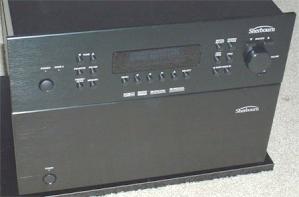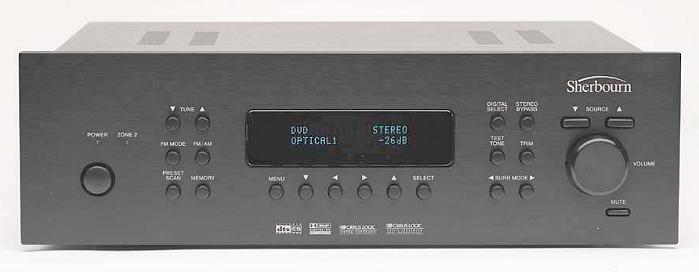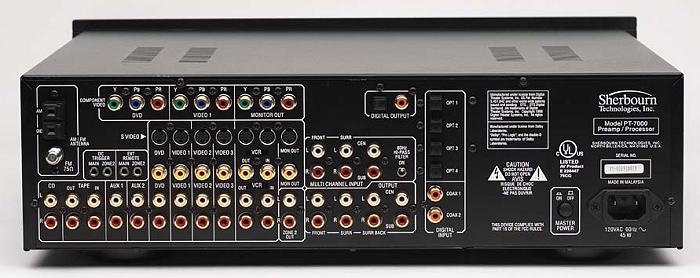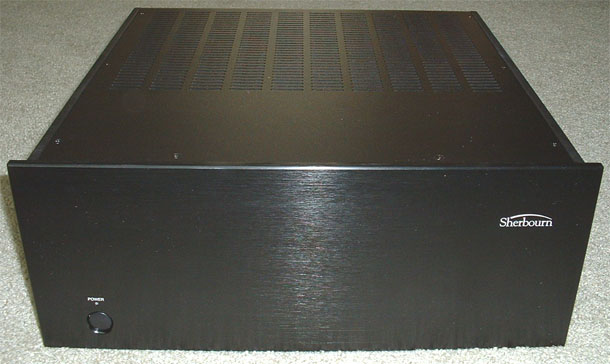|
|

|
|
Specifications:
PT-7000 (SSP)
●
7.1 Operation
●
Bass Management: Crossovers at 40 Hz to 150
H
●
Input Impedance 26 kOhms
●
MFR: 10 Hz - 20 kHz - 0.5 dB
●
Component Video Bandwidth: 55 MHz - 3 dB
●
Rated Output: 2 V RMS
●
THD: 0.0035%
●
Dimensions: 4.6" H x 17.12" W x 14.76" D
●
Weight: 17.6 Pounds
●
MSRP: $1,500 USA
7/2100 (Amplifier)
●
Power output per channel: 200 W into 8 ohm,
300 W into 4 ohm
●
THD: <0.05% at 8 ohm, <.075% at 4 ohm
●
Output load impedance: 8 or 4 ohm in normal
mode, 8 ohm minimum in bridged mode
●
Input load impedance: 20 kohm (balanced or
unbalanced)
●
Input sensitivity: 1.1 V (balanced or
unbalanced)
●
Power bandwidth: 5 Hz to 75 kHz
●
S/N ratio: 100 db wideband, 110 db
A-weighted
●
Power requirements: 120 V, 2 x 15 A
●
Dimensions (W x H x D): 19" x 7"x 17.7"
●
Weight (in carton): 115 lbs
●
MSRP: $ 2,850 USA
Sherbourn Technologies
www.sherbourn.com | |
Introduction
Sherbourn Technologies is a young company that has been known for its affordable high quality power amplifiers. In fact, Sherbourn was the first to introduce a five-channel amplifier
incorporating monoblock design, with each monoblock having its own toroidal transformer (the model 5/1500 amplifier).
As an extension to that
design, Sherbourn has introduced a seven-channel monoblock amplifier, the
7/2100, which is one of the products reviewed here. Recently, the company
has expanded its product line to also include a preamp/processor/tuner,
the PT-7000, which is the other product in this review.
The PT-7000 preamp is 7.1 capable and was designed to match cosmetically
with the 7/2100 amplifier. Both the PT-7000 preamp and the 7/2100
amplifier are finished in black with anodized faceplates. There is
nothing fancy about the appearance of this matching pair, but they do
possess a clean no-nonsense look. They seem to be solidly built as well.
PT-7000 Features
First of all, you may be aware that there are other surround processors
from other companies that look very similar and have similar features to
the PT-7000, such as the Outlaw Model 950 and the Atlantic Technology
P-2000. I found out that they are indeed based on the same design, as
they are outsourced from the same Asian OEM company. Besides their
faceplates, the main difference among them is the components used inside.
Note that many companies outsource their product manufacturing to OEM
suppliers who simply build the products to that specific company's
specifications.
The PT-7000 preamp uses a Cirrus Logic chip for its surround processing. It
is capable of processing most of today's surround formats, which includes
DD, DD-EX, DTS, DTS-ES, Dolby Pro Logic (DPL), DPL II, and DTS-Neo:6.
In addition to these modes, the PT-7000 also offers the
so-called Cirrus Extra Surround, which is a decoding algorithm to create
6.1 or 7.1 output from matrix encoded or discrete audio signals. The
Cirrus Surround in this preamp is available as an enhancement to DPL II
and DD modes.
The
PT-7000 is equipped with 24 bit/192 kHz DACs and 24 bit/96 kHz ADCs from
Crystal Corporation. The crossover settings are selectable in the 40 Hz to
150 Hz range (in six increments) and can be adjusted independently for the
front, center, and surround speakers. The capability to independently
adjust the crossover of the three speaker groups is a very nice feature,
but it has to be used with caution. If one has small surround
speakers, one might tend to use higher crossover frequency for the
surrounds. This is all fine, but beware that bass frequency higher than 80
Hz can be localizable. So the use of higher than 80 Hz crossover
frequency, especially for surrounds, could mess up the overall surround
effect. I suggest using 80 Hz or lower crossovers all around,
which also means that the satellite speakers used should have lower than
80 Hz frequency response.

The
input output connectors on the back of the PT-7000 are neatly arranged and
should be more than sufficient for a typical home-theater setup. On the
audio side, there are nine stereo analog inputs, six digital inputs (four optical
and two coaxial), and one 5.1 analog direct input. All the stereo analog
inputs can be bypassed through a push of a button on the front panel or on
the remote control. This stereo bypass mode defeats the DSP processing
section of the preamp, but the main speaker crossover remains active. So
in the bypass mode, you can still use your subwoofer to augment your main
speakers if necessary.

Basic bass management feature is provided for the
5.1 input, which can be activated from the switch on the back. Setting
this switch in the ON position activates an 80 Hz high pass filter for the
5.1 direct input, except the subwoofer. This feature sends signals of 80 Hz
and lower from the five channels to the subwoofer. In the OFF position, full
range audio signals will be sent to all channels. This preamp has a set of
7.1 analog outputs to drive your amplifier and also two digital outputs (1
optical and 1 coaxial). A stereo second-zone output is also provided. With
it, you can send a second source signal to another amplifier in a
different room or another device (e.g., for recording).
On the video side,
the PT-7000 can accept five composite, five S-Video inputs, and two sets of
component video input. The component video switching has a bandwidth of 55 MHz,
but 100 MHz would have been preferable. This preamp converts automatically from
composite to S-Video or vice versa, which can be handy in some situations.
One set of outputs is provided for each type of video connection. Other
types of connections on the back panel of the PT-7000 include FM/AM
antenna terminals, DC triggers, and remote extension jacks.
The front panel of the PT-7000 is relatively clean, but functional. You can
set up and operate the PT-7000 from the buttons on the front panel alone.
The display in the middle of the front panel shows the operating status of
the preamp in green lettering. Depending on the mode, this two-row display
indicates the program source, surround mode, tuner frequency, volume
level, and some other preamp operating information. This display is
dimmable by changing the brightness level in the setup menu.
The PT-7000 comes with a programmable remote control. I have encountered
the exact same remote several times, bundled with other equipment
that made a stop in my audio rack. But even though I have had some
experience with this remote, I never grew accustomed to it. It is quite a
versatile remote, and probably one that could replace
your other components' remotes, but in my opinion, the layout of its
buttons is not very logical. Your mileage may vary though. The nice thing
about the remote is it is back-lit, so using it in the dark is not a
problem. Pretty much all the functions of the PT-7000 can be accessed
using the remote control.

7/2100 Amplifier Features
Let
me start by saying that the Sherbourn 7/2100 amplifier is a heavyweight
monster (100 pounds). It packs seven monoblock amplifiers capable of delivering 200 W
each into an 8 ohm load (300 W into 4 ohm) in a single chassis. Some people use the raw measure that the heavier the
amplifier, the better. If you are from that school of thought,
then you will be very happy with this amplifier. But I'm not sure if your
back is with you on this. Lifting this amplifier is an adventure, not only
because of its weight, but also because no lifting handles are provided.
To think of it positively, burglars will think twice about taking this
thing.

The
7/2100 amplifier uses two power chords, which should be connected to two
different electrical outlets. This is because the 7/2100 may draw more
current than a single outlet could provide (a typical outlet could handle
up to 15 A of electric current), especially when it is used to drive low
impedance speakers. In my opinion, this is a more elegant solution than
requiring one to install a dedicated 20 A outlet, as some high-current
amplifiers from some other manufacturers require.
The 7/2100 amplifier can accept balanced or unbalanced inputs. High
quality five-way binding posts are used for the output terminals. All the
input and output connectors are gold plated and seem to be very robust, so
I have nothing but praise for the build quality of this amplifier. While the
spacing of the input terminals is nice, the between-channel spacing of the
binding post output terminals is a little too close. The spacing was fine
if banana plugs are used, but with spade plugs, I found that the spacing
was too tight.
One of the nice features of the 7/2100 amplifier is that it is bridgeable.
Three pairs of the input channels on the back are separately grouped, and a
bridging switch is provided for each group. Each bridged pair can produce
up to 400 W into 8 ohms. With the bridge capability, you can configure
this seven-channel amplifier into a six-, five-, or four-channel one
depending on your need.
Another nice feature of the 7/2100 amplifier is the inclusion of the Load
Detection System (LDS) switch for checking the correctness of the speaker
connections. This switch can show the status of the speaker connection for
each channel through a colored LED without needing an ohmmeter or a walk
through. Green LED indicates a good speaker connection and correct speaker
impedance, orange indicates an open circuit or high speaker impedance, and
red indicates either a short circuit or a too-low speaker impedance. When
the indicator shows orange or red for a channel, it is suggested that you
check the speaker connection for that particular channel.
Except for the power on/off button, a small blue LED indicator, and the
Sherbourn logo, nothing else clutters the faceplate of the amplifier. This
amplifier can be put in always-ON mode or remotely triggered in two ways:
using automatic signal sensing or 12 V DC voltage.
Use and Performance
The
setup of the parameters in the PT-7000 to get the best out of your speaker
configuration is relatively easy, and the procedure is quite logical. If
you have some familiarity with a multi-channel surround processor
and can navigate yourself through the PT-7000 menu system, then you need
only minor help from the manual, which by the way explains everything in
good detail and is clearly written. The on-screen display
capability of the processor just makes the setup process easier. The
PT-7000 menu is simple, but covers all the necessary basics, such as
speaker configuration, speaker delay (by distance from the listener), and
level calibration. In addition, you can preset the default settings for
each input, which adds to your convenience, because you don't have to
change the settings every time you change input. Once you have it setup
and running, you can just use the preamp's front panel display to check
its operating status. My only complaint about the display is that the
lettering is too small. I sat about 10-12 ft from the preamp and at that
distance in full brightness, the display was still readable but not
without some effort. The display is dimmable to half brightness, but you
cannot turn it off altogether.
I evaluated the performance of the combo PT-7000 and 7/2100 in a two-channel
setup, as well as 5.1 and 7.1 setups. First, let me say that in any of those
configurations, this combo always displayed solid performance and never
disappointed.
The PT-7000 preamp is not only feature-laden, but it also performs
admirably. As far as I'm concerned, it didn't possess a serious operational
quirk. Sure there were some operational features which I found to be not
to my liking, but they were relatively minor. For example the speaker
distance adjustment is only in 1 ft increments, not in 0.5 ft as I'd rather
have, and it didn't provide separate adjustments for the side and rear
surrounds (if you have an odd setup where the difference in distance
between the side and rear surrounds is large, this might be a problem). Also I would prefer finer channel volume level adjustment than just
the 1 dB steps provided in the PT-7000. The lock-in to digital signal was
also not immediate, usually took about 2 seconds. My biggest complaint was on its channel
trim feature. When the channel levels were changed using the on-the-fly
level trimming, my saved calibration levels were also changed. And to get
back to the intended calibration level again, one has to change it
manually. If you forget what your calibration values were, you apparently
have to calibrate it again. On-the-fly channel trim feature is of course
nice to have to quickly adjust to various soundtrack mixes, but I prefer
one that does not interfere with my saved calibration.
The tuner section in the PT-7000 was not as good as some others that I
have tried in receiving FM signals. I used my Terk powered antenna with
the tuner and tried to tune in several FM stations that I often listen to.
I could not get clear reception with some stations that normally I could
easily get with my mini-system or my car FM radio.
Once set up correctly, the PT-7000 delivered solid all around performance.
This preamp did not add any harmful artifacts to the sound, such as
harshness or edginess. In stereo mode, I noticed that the presentation
through the PT-7000 was slightly forward compared to my stereo preamp, the Adcom GFP-750. Details and balance
were quite excellent. Vocals might not
be as lush as through my Adcom, but it was not something that you could
easily notice without doing a comparison. The soundstage through the
PT-7000 was also somewhat shallower, but this was only obvious on some
recordings.
On multi-channel music through its 5.1 direct input, the PT-7000 did what
a good multi-channel preamp should do, which is to deliver clear and
transparent sound. With the current state of multi-channel recordings, the
standards of which vary significantly from one recording to another in
terms of the portrayal of the listener position with respect to the
soundstage, those were the only things one could ask for to get good
multi-channel music playback at home. The provision of bass management for
its 5.1 channel input is something that I applaud and I think all surround
processors should have some sort of bass management feature on its
multi-channel direct input. Manufacturers should remember that most of us
don't have the space or resources for accommodating full-range speakers
all around.
In a home theater application, I was very pleased with what PT-7000
delivered. I never felt the lack of clarity or impact in my movie watching
experience with this preamp functioning in the centerpiece of my system.
Its surround performance, in my opinion, could hold the ground well
against the competition in its price range. The Cirrus Extra Surround
processing included in the PT-7000 was a nice bonus. Not only it lets you
use all your speakers in 7.1 channel setup, for less than 7.1 signals, but it also enhances ambience
surround envelopment. Although I still prefer the effects created by the
Lexicon's Logic 7, nevertheless the Cirrus Extra Surround is a nice
enhancement to have.
The PT-7000 was also no slouch in handling video switching. It was
relatively transparent and it did not cause any noticeable degradation in
picture quality.
Part of the reason why the performance of the Sherbourn combo never
disappointed me was the 7/2100 amplifier. Regardless of how good your
surround processor is, without a good multi-channel amplifier to match it,
you won't get a good result. And the 7/2100 amplifier is more than just
good, it is monstrously great! Delivering clean sound with excellent
clarity was never a problem with this amplifier, neither was playing loud
without strain or delivering bass punch when called for. The 7/2100 sound
was quite neutral, but might tip ever so slightly towards bright.
During my evaluation, I had a chance to compare the 7/2100 with another
great multi-channel amplifier, the ATI AT-1505 (5x150 W into 8 ohms), which
I've owned for many years. Through the same set of source, preamplifier, speakers, and cables, the sound with the 7/2100 was
brighter (not necessarily bright) than with the ATI. The Sherbourn played
slightly cleaner with “darker” background than the ATI, which might be
attributed to its monoblock design. Both amplifiers did well in the bass
department, but with some noticeable differences. The ATI delivered more
bass output than the Sherbourn, but the bass of the Sherbourn seemed to be
punchier and more controlled. In terms of other sound attributes, such as
soundstage, image, and detail, both amplifiers performed very similarly. I
would be happy with either of these amplifiers, but if I had to choose one
now, I would give an edge to the Sherbourn because of its slightly cleaner
sounding and more controlled bass. But as with any audio equipment, your
taste and your other equipment should be the deciding factor in choosing
the right amplifier for you.
The bottom line is the Sherbourn 7/2100 is a lot of amplifier for the
money. Its $2850 asking price may sound expensive, but when you consider
that you get more than 1400 W of amplification with it, then it is not.
For the wonderful performance it delivers, this product represents one of
the best values in a seven-channel power amplifier available right now.
Conclusions
Sherbourn has produced a solid combo in the PT-7000 preamp/processor/tuner
and 7/2100 seven-channel amplifier. The PT-7000 preamp packs extensive
features and delivers respectable performance. It can definitely hold its
ground well against the competition in its price class. The 7/2100 is a
great amplifier that I'm sure will complement many home theater
systems nicely. This superb sounding amplifier has ample power to satisfy
even the most power hungry system. At $4350, the combo is not cheap, but
in the world of separates, its price is very reasonable, especially
considering you get so much bang for the buck.
- Yongki Go -
Terms and Conditions of Use

|








